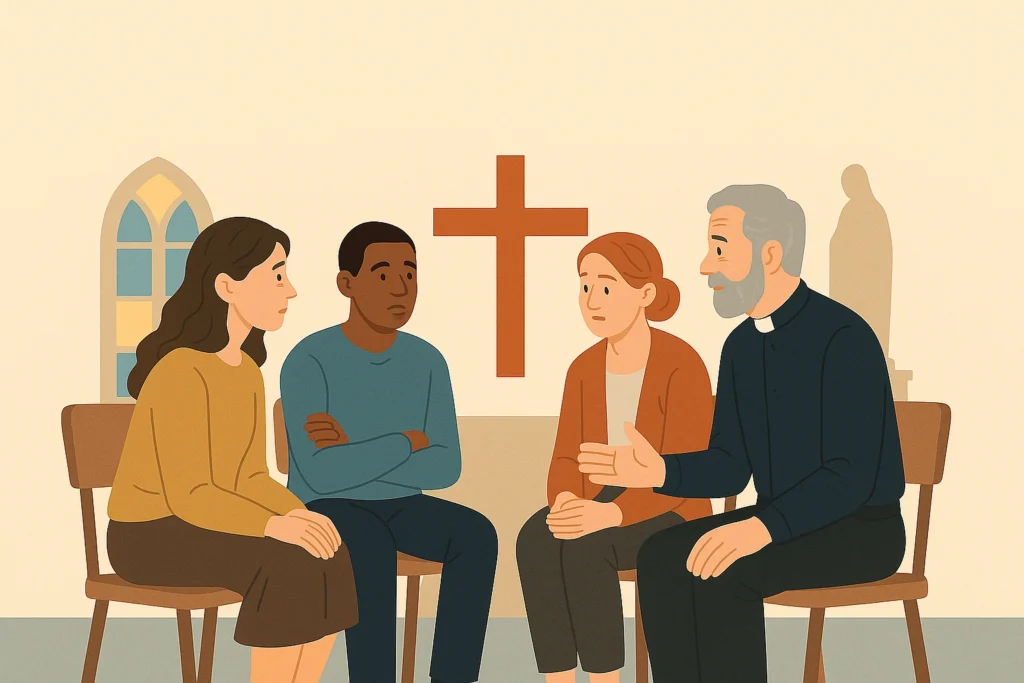Listen to Luke Johanni speak about this article on the Mind and Spirit Podcast!
Healing Trauma (Part 2): Explore how Catholic teaching and modern psychology together offer a path to healing.
Our scars aren’t proof of defeat. They’re proof that love can touch pain and bring life out of it.
Welcome
Hi friends! Welcome back to Mind and Spirit, the podcast where Catholic faith meets psychology and we explore what real healing looks like. I’m Luke Johanni, your Catholic-integrated therapist—helping you bridge faith and mental health so you can find peace, purpose, and restoration.
Don’t forget to subscribe, follow @LukeJohanni on social media, and visit here to submit your questions. They might even be featured in a future episode.
Let’s dive in.
Today’s Subject
In the last episode, Part 1 of Healing Trauma: With Psychology and Faith, we talked about what trauma really is: how it reshapes the brain, tenses the body, and can even make God feel far away (van der Kolk; NIMH; Psalm 34:18). We explored why those responses aren’t signs of weakness but evidence of how the nervous system protects us.
Today, in Part 2, we move from understanding to healing through action. We’ll talk about what recovery looks like when psychology and faith work hand in hand; how therapies like CBT and EMDR help the brain release what’s trapped, and how prayer, community, and the sacraments help the soul rediscover peace (CBT Explained – APA; EMDR Therapy; CCC 1505).
This episode is about learning to live again; not just to survive, but to be restored.
So if Part 1 helped you understand your pain, this one will help you find your path forward.
Therapeutic Paths to Healing Trauma
Before we move forward, pause for a moment. Every story of healing starts with a small “yes,” a willingness to turn toward what hurts instead of away from it. Therapy helps organize what once felt chaotic, and faith reminds us that God is present even in that slow reordering. Together they teach us that healing isn’t about erasing pain; it’s about learning to live freely beyond its grip (Victor Frankl).
1. Trauma-Focused CBT
It pairs cognitive work, challenging distorted thoughts, with gentle, guided exposure to painful memories so they lose power over you.
That brings us to the first practical step on this path: Trauma-Focused Cognitive Behavioral Therapy, or TF-CBT. This approach helps us understand how trauma reshapes our beliefs about safety, trust, and control (Trauma-Focused CBT – APA). It pairs cognitive work, challenging distorted thoughts, with gentle, guided exposure to painful memories so they lose power over you. The process is gradual, but it restores a sense of agency: the belief that you can face what happened without being consumed by it.
TF-CBT in Practice
In practice, this could look like a woman, who grew up in a home where anger meant danger, might find herself panicking anytime someone raises their voice. In therapy, she would work with the therapist to begin noticing that automatic thought: “I’m not safe.” Together, they continue to test it against the present moment: “I’m an adult now. This isn’t my father yelling; this is a coworker who’s frustrated.” And so on. Over time, her body learns that current conflict isn’t the same as past danger.
Another example might look like, a man, who was betrayed in a relationship, might believe, “I can’t trust anyone.” Through CBT, he learns to catch that belief, check it against truth “Some people hurt me, but not everyone will” and change it through God’s grace: “God still calls me to love wisely, not fearfully.”
CBT Technique Example
This takes us back to that simple “3 C’s” skill:
- Catch the lie (“I’m ruined”).
- Check it against truth (“I’m wounded, but not worthless”).
- Change it with grace (“Christ is rebuilding me”).
This integrates well with faith. Romans 12:2 says, “Be transformed by the renewal of your mind.” And that’s what we are working to achieve. Prayer, journaling, and Scripture reflection fit naturally here. They help rewrite the story with God present in it.
2. Eye Movement Desensitization and Reprocessing (EMDR)
EMDR allows us to hand over those miseries at a neurological and spiritual level, which lets both body and soul release what was trapped.
EMDR uses bilateral stimulation, which is eye movements, tapping, or alternating tones, to help the brain re-file traumatic memories so they’re stored as past events instead of current threats (EMDR Therapy). Think of it as the nervous system finally learning, “That was then, this is now.”
I’ll give you a practical example of what this looks like. This would be someone who survived a car accident might still tense up every time they hear screeching tires. In EMDR, they briefly recall that moment while following a gentle left-right tapping or light pattern. The brain processes the sensory fragments, linking them with a sense of safety. Over time, the sound becomes just a sound again, not a panic trigger.
After sessions, quiet reflection, journaling, or even a few minutes before the Blessed Sacrament can help anchor this peace.
Theologically, CCC 1505 tells us Christ “makes our miseries His own.” EMDR allows us to hand over those miseries at a neurological and spiritual level, which lets both body and soul release what was trapped.

3. Somatic and Spiritual Practices
As discussed, trauma isn’t only cognitive. It’s embodied. The body remembers what the mind tries to forget, so healing must include both (van der Kolk). Somatic work helps the body relearn what safety feels like.
Somatic Practices
Let’s look at grounding as an example. If you feel panic rising, pause and name five things you can see, four you can touch, three you can hear, two you can smell, one you can taste. While doing this, pray slowly, “Be still and know that I am God” (Psalm 46:10). This simple exercise pulls you out of the past and back into the present.
Now let’s look at a movement and rest based example. Regular exercise, slow stretching, or even a quiet walk while praying the Rosary helps regulate your nervous system. Each bead becomes a rhythm of calm, a physical reminder of God’s nearness. Sunday rest and healthy sleep patterns are also forms of therapy; they help tell your body the danger is over.
Spiritual Practices
Finally, on a Sacramental level.
Confession releases shame that the body often carries as tension. If approached this way, the Eucharist can also become a place of secure attachment, God’s way of saying, “You are safe with Me.” And the Anointing of the Sick, which may or may not be applicable to you, can bring deep peace to those whose trauma has touched both body and soul (Fr. Jim McManus).
The Importance of Belonging
All of these therapies and practices help individuals begin to heal. But healing was never meant to stay private. The work that happens in therapy or prayer only reaches its fullness when it’s met with love and Christ filled community. We can do all the inner work in the world, but if we return to environments that shame, misunderstand, or isolate pain, those wounds struggle to stay closed.
Healing Through Relationships
That’s where the Church is called to step in, not just as a place of worship, but as a place of belonging. The same grace that transforms hearts can also transform communities.
Healing trauma isn’t a solo project. Just as St. Dymphna’s Geel embraced those suffering with mental illness, we’re called to create parishes and communities where people in pain are not treated as problems but welcomed (Psychiatric Times).
Building Trauma-Aware Communities
That means becoming trauma-aware communities that reflect Christ’s mercy in very practical ways:
- Listening before advising. Sometimes people don’t need quick answers. They need presence.
- Encouraging therapy as cooperation with grace, not as a lack of faith. Seeking professional help is one way of stewarding the life and mind God has given us.
- Building small groups, ministries, and prayer circles that model safety, confidentiality, and compassion.
The Church As Community
Pope Francis often says that the Church is a field hospital. Every Mass proclaims that brokenness can become communion and that the place of our deepest wounds can become the place where Christ is most present.
When the Body of Christ becomes a safe place for wounded bodies and hearts, the Gospel moves from words to witness. Healing becomes something we share, not just something we seek.

Practical Steps for Healing
Healing isn’t about becoming who you were before the trauma; it’s about becoming the person God is forming through it.
Belonging creates the soil where healing can grow, but it still needs tending. Healing is built through small, consistent acts of courage; the kind that retrain both the nervous system and the soul to trust again. These steps aren’t meant to fix everything overnight; they’re practices that help you live like healing is already underway.
1. Start Where You Are
You don’t need to have everything figured out to begin. Maybe that means scheduling your first therapy session, journaling about what you’ve been avoiding, or simply admitting, “I’m not okay right now.” Healing begins in honesty. God meets you in that truth. Psalm 51:6 reminds us “You desire truth in the inward being; therefore teach me wisdom in my secret heart.”
2. Create Rhythms of Safety
When life has taught your body to expect danger, safety has to be relearned on purpose.
- Take five slow breaths, inhaling “Jesus,” exhaling “I trust in You.”
- Step outside, feel the air, name what you see and hear.
- Keep a calming object with you — a Rosary, a smooth stone, a cross — something that tells your nervous system, “I’m safe right now.”
Tiny practices like these signal to the amygdala and body: the threat is over.
3. Connect Before You Correct
When old wounds flare up, we’re tempted to scold ourselves: “I should be past this by now.” Instead, start with compassion. Notice what you feel before trying to fix it. You might pray, “Lord, show me what this emotion needs, not what it deserves.”
Connection calms the brain far more than criticism ever will (Henri Nouwen). Once you feel grounded, then you can apply CBT tools, Catch, Check, Change, from a place of grace, not shame.
4. Invite God Into the Memory
If painful memories surface, you don’t have to face them alone. Picture Jesus present in that scene; not erasing it, but standing beside you in it.
You can pray, “Jesus, where were You in this moment?” Often, the image that comes is exactly what the heart needs: His quiet presence in the place you once felt abandoned. That’s what it means for Christ to “make our miseries His own.” (CCC 1505)
5. Seek Safe Relationships
Healing happens in relationship, not in isolation. Reach out to someone trustworthy — a friend, mentor, priest, or counselor — and share a piece of your story. You don’t need to tell everything; start small.
Remember: trauma is healed by the same thing that was damaged; relationship and trust.“Bear one another’s burdens, and so fulfill the law of Christ.” (Galatians 6:2)
6. Return to the Sacraments
The sacraments are God’s embodied therapy. In Confession, we release shame. In the Eucharist, we experience secure attachment — perfect love given and received. In Anointing, Christ touches our wounds with healing oil. These are not abstract rituals; they are encounters that tell your body and soul, “You are seen, forgiven, and loved.”
7. Rest Without Guilt
Many trauma survivors struggle to rest; their bodies equate stillness with danger. Choose one small act of rest each day — a quiet meal, a walk without headphones, five minutes of silence. Call it holy rest. It’s not laziness; it’s participation in God’s command to “be still and know that I am God.” (Psalm 46:10) Rest teaches your nervous system that peace is possible again.
8. Keep Hope Near
Progress will be uneven. Some days you’ll feel free; others you’ll feel like you’ve gone backward. That’s okay. Healing is not linear, it’s relational. Keep symbols of hope nearby: a favorite verse on your mirror, a candle, a journal of answered prayers. These remind you that the same God who began this work will carry it to completion. “He who began a good work in you will bring it to completion.” (Philippians 1:6)
Healing isn’t about becoming who you were before the trauma; it’s about becoming the person God is forming through it. Every time you breathe, pray, reach out, or rest, you’re teaching your body and soul the truth: You are safe, you are loved, and you are being restored.

A Closing Invitation
If trauma teaches us anything, it’s how strong our survival instinct really is. But God’s desire for us isn’t just to survive. It’s to be live fully. Healing is what happens when the body no longer lives in the past and the soul begins to rest in the present.
St. John Paul II preached that through therapy, faith, and community, we slowly learn that pain doesn’t have the final word: resurrection does. The same Christ who entered our suffering walks with us now, patient and gentle, waiting for the moment we can say, “I’m safe enough to live again.”
And maybe that’s what this whole journey is about. Learning that safety, peace, and belonging are not things we have to earn. They’re gifts, nourished in us by grace.
If you’re walking through trauma or supporting someone who is, remember: you’re not alone. Healing takes time, and that’s okay. Keep showing up: to therapy, to prayer, to community. Every step counts.
Remember
You are not defined by what happened to you. You are defined by the One who heals you.
Prayer
Let’s Pray
Lord Jesus,
You know what it means to carry pain in Your body and sorrow in Your heart.
You entered our wounds so that none of us would ever have to walk through them alone.
For every listener who still feels unsafe in their own skin,
breathe Your peace into the places that tremble.
Calm the body, quiet the mind, and soften the heart.
Remind us that our story doesn’t end in fear — it ends in resurrection.
Teach us to trust again: in You, in others, and in the good You are rebuilding within us.
Make Your Church a place of refuge.
Make our homes places of compassion.
And make our hearts places where love becomes stronger than fear.
We ask this through the same Christ who was wounded and rose for us.
Amen.
Closing
Thanks so much for spending this time with me on Mind and Spirit. If today’s episode spoke to you, don’t rush past it. Take a quiet moment to breathe and let God meet you right where you are.
If this episode encouraged you, I’d love for you to subscribe, leave a review, and share it with someone who might need it. Your support not only helps this show grow. It helps more people find hope and healing through faith.
To connect with me personally, follow and message me on Instagram @LukeJohanni, or visit RestoredChristianCounseling.com for more resources.
And if you have a question you’d like me to answer in a future episode, just head to the Podcast page on my website and submit it. I’d love to hear from you.
I’m Luke Johanni, and this has been Mind and Spirit. Until next time, may the peace of Christ be with you.
Sources/Resources
- The Body Keeps the Score — Bessel van derKolk, M.D.
- Catechism of the Catholic Church §§ 1501
- Catechism of the Catholic Church §§ 1505
- Salvifici Doloris — St. John Paul II
- APA Dictionary of Psychology | TraumaDefinition
- APA — Post-Traumatic Stress Disorder Overview
- NIMH — PTSD and Trauma Basics
- Trauma-Focused CBT – APA
- Psychiatric Times | St. Dymphna and the GeelCommunity
- EMDR Therapy — Francine Shapiro
- The Healing Power of the Sacraments — Fr. JimMcManus, C.Ss.R.
- The Wounded Healer — Henri J. M. Nouwen
- Man’s Search for Meaning — Viktor E. Frankl
- NAMI FaithNet
- Galatians 6:2
- Philippians 1:6
- Psalm 46:10
- Psalm 51:6
- Romans 12:2
When God Feels Far: Why You Feel Abandoned and How to Find Him Again (Part 2)
When God Feels Far: Why You Feel Abandoned and How to Find Him Again (Part 1)
Healing Trauma: With Psychology and Faith (Part 2)
Healing Trauma: With Psychology and Faith (Part 1)
Healing Scrupulosity and OCD: A Proven Path of Faith
The Truth About Anxiety: One Size Doesn’t Fit All

Have a question? Want it answered?
Submit your question below and it maybe answered on the Mind and Spirit Podcast and in this Blog.
Follow me on Instagram and Facebook or subscribe to the blog for weekly encouragement.







